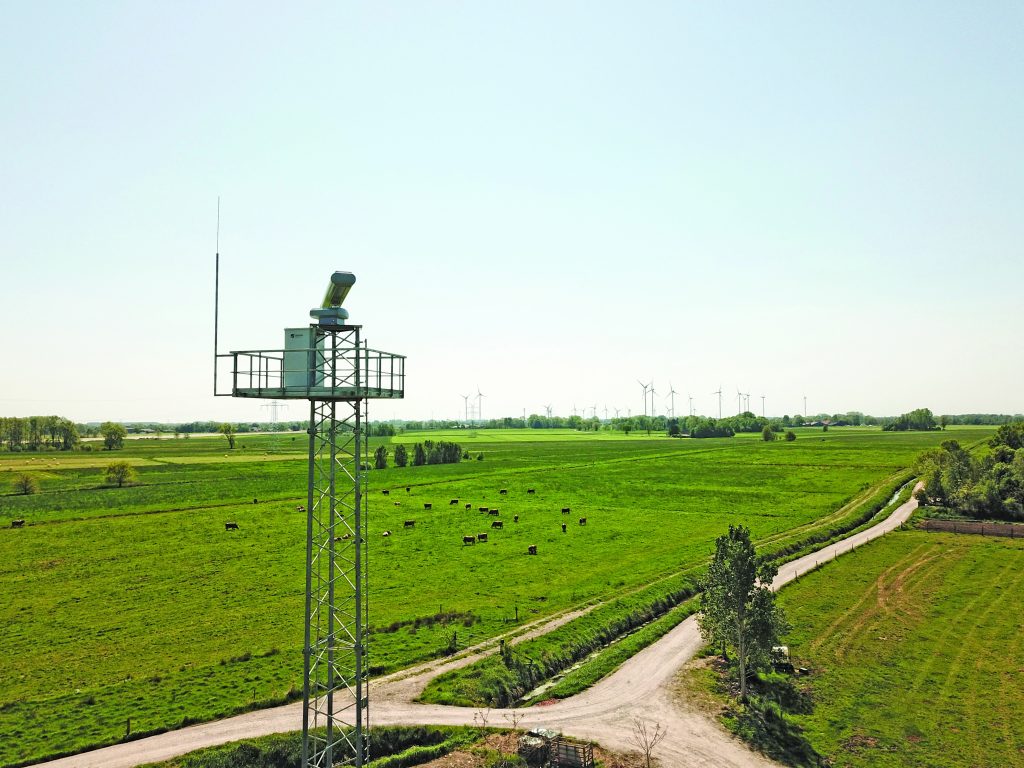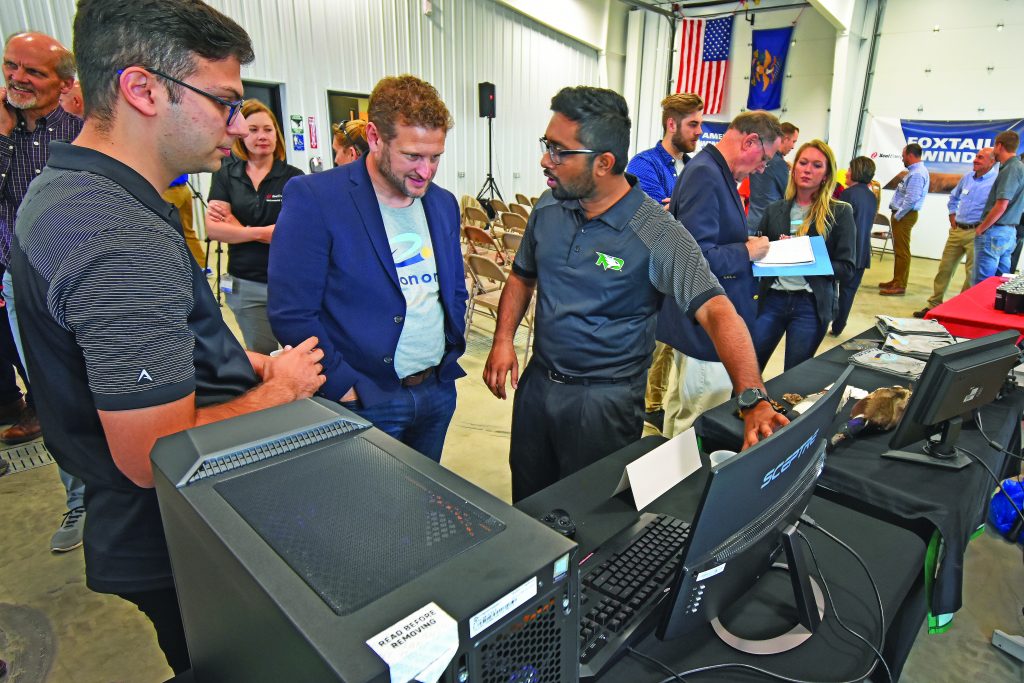Xcel Energy’s Foxtail Wind Farm in Dickey County, North Dakota, will soon be operational, bringing with it a convergence of technologies that will have far reaching implications beyond Foxtail’s 75 turbines.
Wind farms are not uncommon in North Dakota. In fact, wind contributes 25.8 percent to the state’s electrical grid. According to the American Wind Energy Association (AWEA), North Dakota generates 3,155 MW from wind, and has another 256 MW under construction, including Foxtail. As Xcel Energy’s third wind farm in the state, the company will use Vestas V-120 and V-110 turbine generators to add 150 MW of electricity, enough to power 80,000 homes. The site was developed by Wanzek of Fargo, North Dakota.
North Dakota Lt. Gov. Brent Sanford, one of the speakers at the American Wind Week event at Foxtail on August 14, said that the state’s wind industry continues to grow.
“Per capita, we are the No. 1 state for wind-generated power,” he said. “North Dakota may represent only two-tenths of 1 percent of the nation’s population, but as of May of 2019, we are now ranked ninth in the nation for total megawatts generated by wind.”
“Wind plays a vital role in our energy portfolio — providing jobs, income to our rural communities, and tax revenue to our local and state governments while contributing to our nation’s energy dominance,” Sanford said. “Energy production is not a zero-sum game. As long as we continue to grow, our grid has room for everyone.”
According to Teresa Mogensen, senior vice president, transmission at Xcel Energy, nearly 20 percent of Xcel’s energy supply company-wide comes from wind energy, seven times what it was in 2005.
“We are expecting to surpass 11,000 MW of wind capacity on our system in the next few years, with a dozen new projects, including Foxtail,” she said.
Maintaining Good Relations
At the event, Mogensen talked about the importance of maintaining good relations with land owners and the community.
“Being a good neighbor is also about listening,” she said. “We understand that the flashing red warning lights on the towers are a critical safety tool, but they’re also difficult to live with at all hours of the night.”
North Dakota Public Service Commissioner Julie Fedorchak said the state considers minimal impact to the environment and community organization when issuing permits for power-generation facilities such as wind farms, transmission lines, gas plants, and refineries.
“One of the big impacts that is a consistent concern for citizens is the annoyance of the blinking red lights,” she said.

But, according to Fedorchak, Xcel Energy is actually doing something about it. Foxtail is the first facility where the Aircraft Detection Lighting System (ADLS) system will be up and running from day one of operations.
“It’s a great way to mitigate one of the complaints about wind energy and make it more tolerable to all people living around it, without negatively impacting the efficiency of the project at all,” she said.
OLC Solution
To meet that community desire for dark skies at night consistent with FAA safety requirements, Xcel Energy installed Terma North America’s Obstruction Lighting Control (OLC) solution, featuring Terma’s SCANTER 5202 surveillance radar to enable the aircraft warning lights anytime an aircraft is within three nautical miles of a wind turbine.
The SCANTER 5202 can be configured with a 12-foot compact antenna for a 23-mile diameter circle of coverage or an 18-foot high-gain antenna for a 32-mile diameter circle of coverage, depending on the size of the wind farm and the location of the radar.
“Our range, performance, and the ability to see extremely small targets in extremely harsh weather conditions, as well as unique technical capability that allows the SCANTER 5202 to detect and track targets despite the interference generated by the movement of the turbine blades, makes the SCANTER 5202 ideal for the FAA’s ADLS requirements,” said Jeff Schleicher, Terma’s senior manager for wind-energy services.
Xcel Energy spokesman Matt Lindstrom said the decision to select Terma came from collaboration between internal Xcel Energy teams who evaluated all proposals and determined that Terma best met the project’s requirements.
“We are planning to install more aircraft lighting detection systems on our Border and Courtney wind farms in North Dakota and our Blazing Star 1 and 2 wind farms in Minnesota,” he said.

More than just a Light Switch
But Foxtail is first, and the 20,000-acre facility is unique in more ways than one. The radar, it turns out, can do more than switch the lights. With support from the state, the OLC radar is also enabling a fully autonomous solution for turbine inspection, wildlife assessment, security, and perimeter checks.
Xcel Energy already had partnered with the Northern Plains UAS Authority to use drones for transmission line inspections. To fly the drones beyond visual line of sight, the airspace must be clear of other aircraft.
That capability can be enabled by radar, and the Foxtail OLC radar can show the drone operator that the airspace is clear so they can safely use the drones at the wind farm to inspect the turbines and blades.
Nicholas T. Flom, executive director for the Northern Plains UAS Test Site, said the presence of the OLC radar at Foxtail created new possibilities beyond turbine inspections, such as using drones instead of manned “crop duster” aircraft for insect or weed control, for example.
“We are pursuing ways to take advantage of the radar technology to also allow us to safely operate drones — multiple drones — autonomously beyond the line of sight of the pilot,” Flom said. “When we started this entire project of trying to make turbine inspections more efficient, we didn’t even know that there was going to be all these additional possibilities coming out of it. This was just an idea a year ago.”
The state is helping to make it happen. North Dakota Commissioner of Commerce Michelle Kommer said the state’s Renewable Energy Program has provided a grant for $500,000 to assist North Dakota software company Airtonomy to develop a framework for secure, remote, autonomous, multi-drone operations.
“Partnering with Airtonomy on this groundbreaking work is Xcel Energy and Microsoft,” she said. “Xcel Energy will implement this solution at Foxtail, which will model innovative use of technology and demonstrate building blocks for autonomous operations featuring unmanned aircraft systems.”

Furthermore, Kommer said the state invested nearly $300,000 to work with the University of North Dakota’s Research Institute for Autonomous Systems (RIAS) and the Northern Plains UAS Test Site to pursue a waiver that will allow Airtonomy to assist in securing autonomous multi-drone and beyond vision line-of-sight operations.
“This project also taps our Innovate ND program, which provides up to $24,000 in funding for new and innovative approaches to doing business,” she said.
Statewide Network Planned
Flom said the state will eventually have a statewide network for operating UAS, enabled by radars at airports and wind farms.
“This is one of the trailblazing type efforts to utilize that, so thank you, Xcel,” he said.
Josh Riedy, CEO of Airtonomy, said the drones will operate from containerized drone housing units that would typically be dispersed throughout a wind farm, with environmental monitoring kits to check wind speed, temperature, precipitation, and whether it’s day or night, to ensure the flying conditions are acceptable.
“We have a launch sequence that verifies clear air space, and then checks with the Terma radar to ensure the area is devoid of manned aviation,” he said. “When the system gives the green light, it opens the respective housing unit, and the drones will go about doing their work, such as turbine inspection, wildlife assessments, security, or perimeter checks. When the assignments are complete, or when their battery limit is reached, the drones will come back and recharge and be tasked again.”
Riedy said the combination of the Terma radar and Airtonomy software solution is scalable and repeatable, depending on the requirement, and can be applied at wind farms everywhere.
Thanks to the Terma radar, those annoying blinking red lights will come on only when they’re needed, which is to warn an aircraft there’s a wind farm nearby.
“Otherwise,” Commissioner Fedorchak said, “the night sky will be dark, and the wind farm will be invisible to people — the night skies will be illuminated by the stars alone.”



























